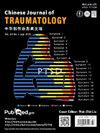自体骨骨膜移植治疗距骨囊状骨软骨损伤:骨重建至关重要。
IF 1.9
4区 医学
Q2 ORTHOPEDICS
引用次数: 0
摘要
目的:自体骨骨膜移植(AOPT)是治疗距骨囊状骨软骨病(OLT)最可行、最有效的技术之一。然而,关于移植物-宿主骨愈合和骨关节面重建过程的报道却很少,这有助于我们进一步了解骨愈合的实际情况并修正手术方法:我们回顾性评估了2016年12月至2021年10月接受AOPT治疗OLT伴软骨下囊肿的30例患者的33处骨软骨病变。根据CT观察结果,我们用4个变量来描述骨关节修复情况,包括关节面的整合情况、骨填充高度、骨结合状况以及骨吸收或囊变的出现。我们还分析了人口统计学数据和临床功能。人口统计学和临床变量采用描述性统计。正态分布数据以均数 ± SD 表示,非正态分布数据以中位数(Q1、Q3)表示。对于连续变量,采用 t 检验或单向方差分析检验这些变量与主要临床结果之间的关系:患者的平均年龄为(41.7±14.0)岁,平均随访时间为(29.6±17.8)个月。软骨病变大小为(14.3 ± 4.1)毫米。囊肿深度为(10.9 ± 3.7)毫米。在术前评估和最近一次随访评估之间,功能结果(根据行走时疼痛的数字评分量表和美国矫形足踝协会评分)有明显改善,27 例移植物(81.8%)的功能结果从(4.2 ± 2.1)降低到(2.2 ± 2.0)(p 1 mm),三分之一的移植物的功能结果为 "低于邻近关节面水平,≤ 1 mm"。骨填充高度异常会影响数字评分量表评分(p = 0.049)和美国矫形足踝协会评分(p = 0.027)。值得注意的是,多达 13 例自体移植物(39.4%)出现骨吸收或囊变:结论:AOPT 是一种有效且可接受的囊性 OLT 技术。结论:AOPT是治疗囊性OLT的有效且可接受的技术,骨重建对大囊性OLT至关重要。如何更好地进行骨关节重建,避免囊肿复发,仍需进一步关注。本文章由计算机程序翻译,如有差异,请以英文原文为准。
Autologous osteoperiosteal transplantation for cystic osteochondral lesions of the talus: Bone reconstruction is essential
Purpose
Autologous osteoperiosteal transplantation (AOPT) is one of the most feasible and effective techniques for cystic osteochondral lesions of the talus (OLT). However, few reports have been reported about the process of graft-host bone healing and bone articular surface reconstruction, which help us to further understand the actual situation of bone healing and modify surgical methods.
Methods
The case series study retrospectively evaluated 33 osteochondral lesions in 30 patients undertaking AOPT for OLT with subchondral cysts from December 2016 to October 2021. According to CT observation, we used 4 variables to describe the bony articular repair, including the integration of the articular surface, the height of the bone filling, the status of bone union, and the appearance of bone resorption or cystic change. We also analyzed the demographic data and clinical function. Descriptive statistics were used for demographic and clinical variables. Normally distributed data were presented as mean ± SD, and non-normally distributed data were presented as median (Q1, Q3). Associations between these variables and the primary clinical outcomes were examined using t-test or one-way ANOVA test for continuous variables.
Results
The patients’ mean age was (41.7 ± 14.0) years old and the mean follow-up time was (29.6 ± 17.8) months. The chondral lesion size was (14.3 ± 4.1) mm. The cyst depth was (10.9 ± 3.7) mm. Significant improvements were observed in functional outcomes (according to the numeric rating scale for pain when walking and the American orthopedic foot and ankle society score) between the preoperative and latest follow-up evaluations, from 4.2 ± 2.1 to 2.2 ± 2.0 (p < 0.001), and from 66.8 ± 12.9 to 83.2 ± 10.4, respectively (p < 0.001). The overall satisfaction reached 8.3 of 10 points. All patients returned to sports and their median daily steps reached 8000 steps with 27 (81.8%) patients walking over 6000 steps daily. According to CT observation, “discontinuous bony articular surface and gap > 1 mm” was found in 27 grafts (81.8%), and “below the level of the adjacent articular surface, ≤ 1 mm” in a third of the grafts. Abnormal height of bone filling affected numeric rating scale score (p = 0.049) and American Orthopedic Foot and Ankle Society score (p = 0.027). Of note, bone resorption or cystic changes appeared in up to 13 autografts (39.4%).
Conclusions
AOPT is an effective and acceptable technique for cystic OLT. Bone reconstruction is essential for large cystic OLT. How to get better bony articular reconstruction and avoid cyst recurrence should still be paid more attention.
求助全文
通过发布文献求助,成功后即可免费获取论文全文。
去求助
来源期刊

Chinese Journal of Traumatology
ORTHOPEDICS-
CiteScore
3.80
自引率
4.80%
发文量
1707
审稿时长
28 weeks
期刊介绍:
Chinese Journal of Traumatology (CJT, ISSN 1008-1275) was launched in 1998 and is a peer-reviewed English journal authorized by Chinese Association of Trauma, Chinese Medical Association. It is multidisciplinary and designed to provide the most current and relevant information for both the clinical and basic research in the field of traumatic medicine. CJT primarily publishes expert forums, original papers, case reports and so on. Topics cover trauma system and management, surgical procedures, acute care, rehabilitation, post-traumatic complications, translational medicine, traffic medicine and other related areas. The journal especially emphasizes clinical application, technique, surgical video, guideline, recommendations for more effective surgical approaches.
 求助内容:
求助内容: 应助结果提醒方式:
应助结果提醒方式:


